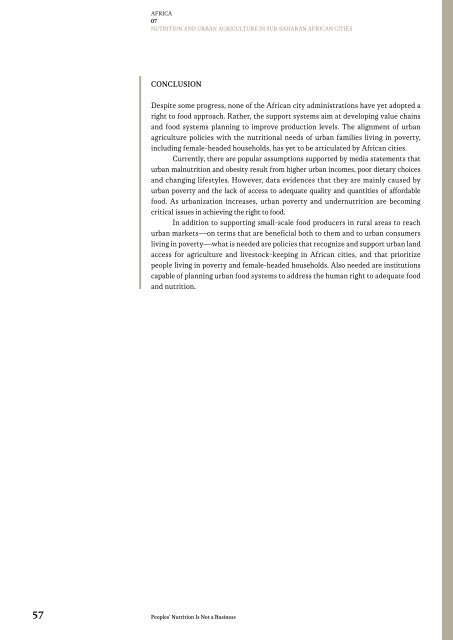RIGHT TO FOOD AND NUTRITION WATCH
1iNBHTY
1iNBHTY
Create successful ePaper yourself
Turn your PDF publications into a flip-book with our unique Google optimized e-Paper software.
AFRICA<br />
07<br />
<strong>NUTRITION</strong> <strong>AND</strong> URBAN AGRICULTURE IN SUB-SAHARAN AFRICAN CITIES<br />
CONCLUSION<br />
Despite some progress, none of the African city administrations have yet adopted a<br />
right to food approach. Rather, the support systems aim at developing value chains<br />
and food systems planning to improve production levels. The alignment of urban<br />
agriculture policies with the nutritional needs of urban families living in poverty,<br />
including female-headed households, has yet to be articulated by African cities.<br />
Currently, there are popular assumptions supported by media statements that<br />
urban malnutrition and obesity result from higher urban incomes, poor dietary choices<br />
and changing lifestyles. However, data evidences that they are mainly caused by<br />
urban poverty and the lack of access to adequate quality and quantities of affordable<br />
food. As urbanization increases, urban poverty and undernutrition are becoming<br />
critical issues in achieving the right to food.<br />
In addition to supporting small-scale food producers in rural areas to reach<br />
urban markets—on terms that are beneficial both to them and to urban consumers<br />
living in poverty—what is needed are policies that recognize and support urban land<br />
access for agriculture and livestock-keeping in African cities, and that prioritize<br />
people living in poverty and female-headed households. Also needed are institutions<br />
capable of planning urban food systems to address the human right to adequate food<br />
and nutrition.<br />
57<br />
Peoples’ Nutrition Is Not a Business


